Vizsla
The Vizsla (Hungarian: [ˈviʒlɒ])[lower-alpha 1] is a dog breed from Hungary and belongs to the FCI group 7 (Pointer group). The Hungarian or Magyar Vizsla are sporting dogs and loyal companions. The Vizsla's medium size is one of the breed's most appealing characteristics. As a hunter of fowl and upland game, the Vizsla has held a prominent position among sporting dogs – that of household companion and family dog.
| Vizsla | |||||||||||||||||
|---|---|---|---|---|---|---|---|---|---|---|---|---|---|---|---|---|---|
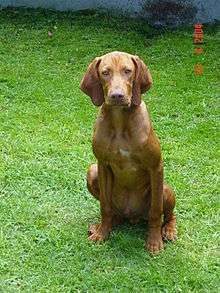 | |||||||||||||||||
| Origin | Hungary | ||||||||||||||||
| |||||||||||||||||
| |||||||||||||||||
| Dog (domestic dog) | |||||||||||||||||
The Vizsla is a natural hunter endowed with an excellent nose and outstanding trainability. It was bred to work in fields, forests or bodies of water. Although they are lively, gentle-mannered, demonstrably affectionate and sensitive, they are also fearless and possess a well-developed protective instinct.[3]
Description
Appearance
The Vizsla is a short-coated hunting dog of distinguished appearance and bearing.[4] Robust, but rather lightly built, they are lean dogs that have defined muscles.
Various breeds are often mistaken for Vizslas and vice versa are commonly mistaken for other breeds. Redbone Coonhounds, Weimaraners and Rhodesian Ridgebacks are most commonly mixed up. The body structure of a Vizsla is very similar in appearance to a Weimaraner and a Redbone Coonhound, though the Vizsla is typically leaner with a more defined musculature. However, Weimaraners and Rhodesian Ridgebacks are larger than Vizslas.
The nose of the Vizsla will always have a reddish color that blends with the coat color. Black, brown, light pink, or another color nose is an indication of another breed. A Vizsla's eye and nail color should also blend with the coat color.[5]
Color and coats
The standard coat is a solid golden rust color in several shadings.[4] The coat could also be described as a copper-brown color, russet gold, and dark sandy gold. Solid, dark, mahogany red and pale yellow are considered faults and a disqualification in competitions. Small areas of white on the fore-chest, neck, or tail are permissible[6] but not preferred. Some variations in the Vizsla coat color along their back (saddle-type marks) are typical.
The American Kennel Club (AKC) breed standards for the Vizsla states that the coat should be short, smooth, dense, and close-lying, without a woolly undercoat. The Vizsla is not suited to being kept outside since, unlike most other breeds, it does not have an undercoat. They are self-cleaning dogs and rarely need to be bathed, if ever. They have little noticeable "dog smell" detectable by humans. After several forays into lakes and streams they will develop an aroma that is a weaker version of the 'wet dog' smell. A quick bath and this odor will vanish.
Size
The Vizsla is a medium-sized dog, The average height and weight:
- Males
- Height: 23–27 in (58–69 cm)
- Weight: 45–66 lb (20–30 kg)
- Females
- Height: 21–24 in (53–61 cm)
- Weight: 40–55 lb (18–25 kg)
- Vizsla appearance
- Vizslas are gentle-mannered dogs
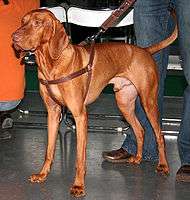 The Vizsla is a short-coated hunting dog
The Vizsla is a short-coated hunting dog Vizsla portrait
Vizsla portrait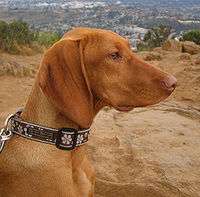 Five-month-old Vizsla with the AKC standard "golden rust" coat
Five-month-old Vizsla with the AKC standard "golden rust" coat
Tail


The American breed standard does call for the tail to be docked to two-thirds of its original length.[7] Breed standards in countries where docking is banned, such as the United Kingdom,[8] do not allow this and docking has been condemned by the American Veterinary Medical Association,[9] the American Animal Hospital Association,[10] and the Canadian Veterinary Medical Association.[11] The Vizsla holds its tail horizontal to the ground and wags it vigorously while charging through rough scrub and undergrowth.
The docked tail of the Vizsla is significantly longer than that of other dogs with traditionally docked tails such as the Weimaraner, Dobermann, Boxer, and Australian Shepherd. Since the tail is docked when the puppy is less than three days old, this longer dock can result in some variation in tail length among Vizsla dogs from different breeding programs.
Temperament
Vizslas are very high energy, gentle-mannered, loyal,[12] caring, and very affectionate. They quickly form close bonds with their owners, children, and even strangers. Often, they are referred to as "velcro" dogs because of their loyalty and affection. Vizslas will cry or whine when they feel neglected or are otherwise unhappy. Some will bark at strangers if they feel that they are invading the "pack" space. They are very good guard dogs when trained to be so.
They are natural hunters with an excellent ability to take training.[4] Not only are they great pointers, but they are excellent retrievers as well. They will retrieve on land and in the water making the most of their natural instincts. However, they must be trained gently and without harsh commands or strong physical correction, as they have sensitive temperaments and can be easily damaged if trained too harshly.[13] However the owner must show quiet authority in training, otherwise the dog is likely to take over the training session.
Vizslas are excellent swimmers. Some may need a little motivation to get in the water but as they get used to it they will love it. Like all hunting dogs, Vizslas require a great deal of exercise to remain healthy and happy.
The Vizsla thrives on attention, exercise, and interaction. They are intelligent dogs and need a lot of mental stimulation when young. If left alone for long hours, they can be bored and become destructive.[14] With proper socialization and training, Vizslas are very gentle dogs that can be great around children. The Vizsla wants to be close to its owner as much as possible.
Health
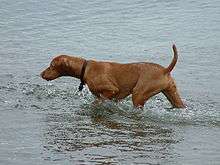
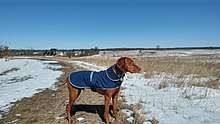
A Vizsla Club of America survey puts the average lifespan of the Vizsla at 9.15 years.[15] The Vizsla is considered to be a robust dog but some localized breeding programs using a small number of dogs have led to heritable illnesses in some offspring including:
- Hip dysplasia is very rare but remotely possible.[16]
- Canine epilepsy
- Cancer (mast cell tumors, hemangiosarcoma, lymphoma)
- Sebaceous adenitis
Responsible breeders do not select dogs for breeding if they have such inherent problems.[17] Vizslas can also suffer from hypothyroidism, dwarfism, persistent right aortic arch, tricuspid valve dysplasia, and progressive retinal atrophy. Major risks include epilepsy and lymphosarcoma. Vizslas can also be prone to skin and food allergies.[18]
Unlike many other dogs, Vizslas do not have an undercoat. Therefore, they are unsuited for living outdoors.[19][20][21][22]
History
The first written reference to the Vizsla dog breed has been recorded in the Illustrated Vienna Chronicle prepared on order of King Louis I of Hungary by the Carmelite Friars in 1357.[23]
As companions of the early warlords and barons, Vizsla blood was preserved pure for centuries by the land-owning aristocracy who guarded them jealously and continued to develop the hunting ability of these "yellow-pointers". Records of letters and writings show the high esteem in which the Vizsla was held.
The Vizsla has survived the Turkish occupation (1526–1696), the Hungarian Revolution of 1848, World War I, World War II and the Hungarian People's Republic. However, Vizslas faced and survived several near-extinctions in their history, including being overrun by English Pointers and German Shorthaired Pointers in the 1800s (Boggs, 2000:19) and again to near-extinction after World War II.[23] A careful search of Hungary and a poll of Hungarian sportsmen revealed only about a dozen Vizslas of the true type still alive in the country. From that minimum stock, the breed rose to prominence once again. The various "strains" of the Vizsla have become somewhat distinctive as individuals bred stock that suited their hunting style. Outside Hungary, vizslas are commonly bred in Romania, Austria, Slovakia, and Serbia.
The Vizsla started arriving in the United States at the close of World War II. As interest in and devotion to the breed began to increase, owners formed the Vizsla Club of America in order to gain AKC recognition. As a result of registering foundation stock with the AKC, Vizsla owners were able to obtain official recognition on 25 November 1960, as the Vizsla became the 115th breed recognized by the American Kennel Club.[3]
The Vizsla was used in development of other breeds, most notably the Weimaraner, Wirehaired Vizsla and German Shorthaired Pointer breeds.[23] There is much conjecture about those same breeds, along with other pointer breeds, being used to reestablish the Vizsla breed at the end of the 19th century.[23]
 The Vizsla thrives on attention, exercise and interaction
The Vizsla thrives on attention, exercise and interaction
Vizsla in the UK
Approximately 4,520 Vizsla puppies are registered with the Kennel Club of Great Britain (KC) each year, making the breed one of the top 50 most popular. The number is steadily rising year after year as more people recognize the breed.[24] There are two breed clubs for the Vizsla in Britain, The Hungarian Vizsla Club[25] and The Hungarian Vizsla Society.[26] The winner of the Best In Show award at Crufts 2010 was a Vizsla named Hungargunn Bear It'n Mind.[27]
In popular culture
- Dana Perino, the former White House Press Secretary and cohost of The Five, has owned a Vizsla, Henry. After his death, Perino got another Vizsla, Jasper.[28]
- Kubrick the Dog, a 2011 photography book by British fashion photographer and film maker Sean Ellis as a tribute to his Vizsla dog named Kubrick.[29]
- Gary Dell'Abate, also known as Baba Booey from The Howard Stern Show, has a Vizsla named "Murphy".[30]
- Comedian Drew Lynch has a Vizsla, Stella, as a service dog. They host a YouTube series called "Dog Vlog".
- Former American professional baseball pitcher Mark Buehrle and his family own three Vizslas: Diesel, Drake, and Duke.
- Ruby the trail dog. A popular Mountain Biking dog from the UK[31]
- Tucker Vizsla is a popular New York City–based Vizsla[32] well known for working with brands, like BMWUSA,[33] as well as his friendly demeanor and handsome appearance.
- Penny is another popular Mountain Biking Vizsla traildog. Penny lives on Vancouver's North Shore.[34]
- Professional basketball player Kevin Love owns a Vizsla[35]
See also
- National symbols of Hungary
- Wirehaired Vizsla, a separate breed from the Vizsla. The Wire-haired Vizsla was developed in the 1930s by the interbreeding of the Vizsla and the German Wirehaired Pointer to get a dog with a more substantial frame and a heavier coat, suitable for working in colder weather.
References
- Sources report various pronunciations in English, with some closer approximations of the Hungarian original like /ˈvɪʒlɔː/,[1] /ˈviːʒlə/, or /ˈvɪʒlə/,[2] and others more influenced by the spelling like /ˈviːzlə/[2] or /ˈviːslə/.[2]
- dictionary.com – Vizsla
- merriam-webster.com – Vizsla
- "Vizsla Club of America". Archived from the original on 17 April 2008. Retrieved 16 June 2008.
- "AKC Vizsla Breed Standard". Retrieved 16 June 2008.
- "Colorado Wyoming Vizsla Rescue Group". Retrieved 16 June 2008.
- "Vizsla Dog Breed Information". akc.org.
- "Breed Standards: Hungarian Wire-Haired Vizsla". United Kennel Club website. Retrieved 1 March 2017.
- "Tail docking". Kennel Club Media Centre. Retrieved 1 March 2017.
- https://www.avma.org/KB/Policies/Pages/Ear-Cropping-and-Tail-Docking-of-Dogs.aspx
- "Ear cropping and tail docking".
- "CVMA | Documents | Cosmetic Alteration – Position Statement".
- Kara Spak (22 January 2009). "Labrador retriever is Chicago's top dog". Chicago Sun-Times. Retrieved 23 January 2009.
- Gottlieb, Gay (2002). The Complete Hungarian Vizsla. Ringpress. ISBN 0-948955-32-5.
- "The VIZSLA". Retrieved 15 September 2015.
- "Vizsla Club of America Welfare Foundation 2008 Health Survey" (PDF). Retrieved 26 June 2012.
- "Orthopedic Foundation for Animals". Archived from the original on 14 June 2008. Retrieved 19 June 2008.
- "Orthopedic Foundation for Animals: Purpose". offa.org.
- Dogster Vizsla Resource. Accessed 20 April 2010.
- Hungarian dog breeds. Dr. Sárkány Pál – Dr.Ócsag Imre. ISBN 963-232-261-4. (in Hungarian)
- "Own a Vizsla". moonmoth.net.
- "Vizsla Dog Breed". hillspet.com.
- "The Vizsla Breed". vizslabonneterrekennel.com.
- Boggs, Bernard C (2000). The Vizsla. Behi Publishing Company. ISBN 0-9700978-0-8.
- KC Registration Statistics Archived 28 June 2007 at the Wayback Machine. Accessed 28 May 2007.
- "Hungarian Vizsla Club".
- "Hungarian Vizsla Society".
- "Crufts 2010 won by Hungarian Vizsla called Yogi". BBC News. 14 March 2010. Retrieved 14 March 2010.
- "White House Press Secretary Avoids Foreclosure on D.C. Home". Fox News. Retrieved 13 December 2012.
- "Vogue Photog Sean Ellis' Book About His Best Friend: Kubrick the Dog". Racked. Retrieved 13 December 2012.
- Photo of Murphy. Accessed 21 August 2009.
- http://rubythetraildog.com/
- https://instagram.com/tuckervizsla
- https://www.instagram.com/p/B0zElTbD7kC/
- https://www.instagram.com/pennythevizsladog/
- https://www.instagram.com/p/Br096S-nyi-/
Further reading
- Boggs, B. C. The Vizsla; Glenbrier Publishing Company; Revised Edition, 1982. ISBN 0-9608838-0-0.
- Coffman, Marion I. Versatile Vizsla; Alpine Blue Ribbon Books; 2nd edition (May 2004). ISBN 1-57779-056-1.
- Hart, Ernest H. Vizslas; TFH Publications, 1990. ISBN 0-86622-436-X.
- Pinney, Chris C., D.V.M. Vizslas: A Complete Owner's Guide; Barron's, 1998. ISBN 0-7641-0321-0.
- White, Robert L. Hungarian Vizsla; PetLove Books (Published in UK by Interpret Books). ISBN 1-903098-59-9.